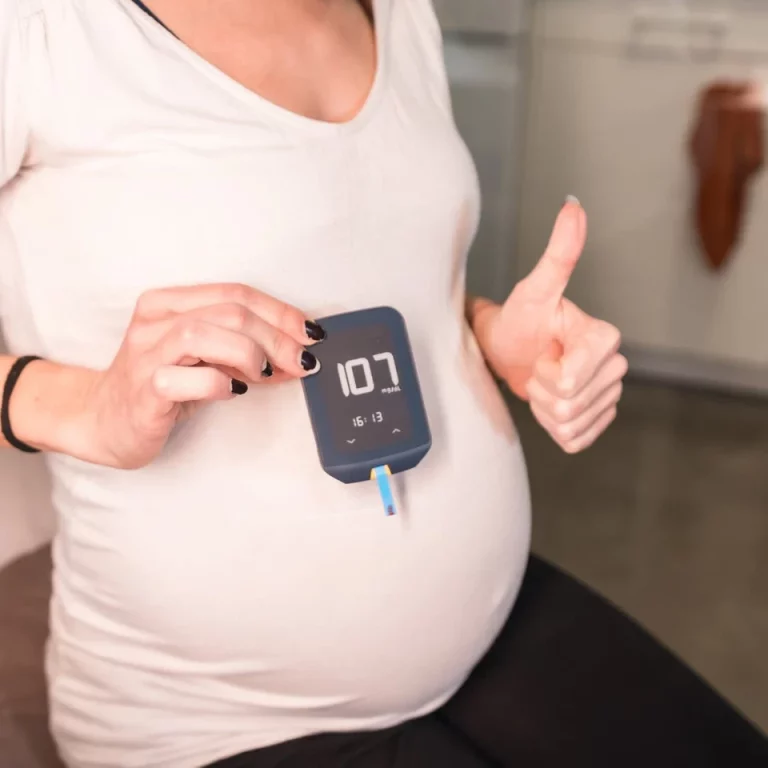Low Back Pain In Pregnancy
As many as two thirds of pregnant people experience low back pain during pregnancy. In fact, it’s one of the most common complaints reported to doctors during pregnancy (1).
As you gain weight during pregnancy and begin to carry more weight in front, you may compensate by leaning back. Leaning back changes your posture and puts strain on the lower back. This shift in the center of gravity causes more stress on your spine and back muscles.
Besides putting strain on your lower back, leaned back posturing makes it difficult to manage intrabdominal pressure and connect to your core muscles, which are the muscles that support and stabilize the spine.
Additionally, the growing baby inside your uterus can put weight and pressure on nerves leading to lower back pain. This nerve compression can also cause hip, thigh or pelvic pain, shooting pains down your legs, or a tingling sensation in your legs.
Finally, the body produces a hormone called relaxin during pregnancy, which loosens and relaxes your joints and softens ligaments. This helps prepare your body for labor and delivery.
Ligaments in your body support the weight of your uterus as it expands, and they can be stretched by the weight of your growing baby. The stretching of these ligaments may also cause pain.
Natural Ways To Reduce Low Back Pain In Pregnancy
- Positional Changes And Support For Back Pain
When possible, try to alternate between sitting and standing. When standing, place one foot on a low stool or box—just make sure it’s stable. This helps take some pressure off your lower back. Whether sitting or standing it is important to be in a good posture, where your ribcage can sit directly on top of your pelvis, your shoulders are relaxed down and back, and your neck is elongated. If you’re going to be sitting for a long time, it can be helpful to place a small stool under your feet or use pillows to help support your spine. try to sit with good posture. Your shoulders should be rolled back and also, with support for your lower back. Try not to cross your legs or ankles when you’re sitting. When you are sleeping, try to sleep on your side with a pillow placed from your groin to your knee. Having a pillow placed this way and not just at the knee supports the weight of your leg and pelvis and prevents sheering in your lower spine. It is also helpful to place a small pillow or folded towel under your belly for support. between your knees and/or under your abdomen. Support belts can be very helpful also. - Massage
A gentle massage can be a great way to ease lower back pain. You should always ask your doctor before getting a massage during pregnancy, but if it’s OK with them, it’s a great way to relax and take care of your body while you’re pregnant. Most massage therapists will not allow you to have a prenatal massage until you are at least in your second trimester so be sure to call ahead of time and ask this before making your appointment. - Exercise & Yoga
Movement and exercise can be helpful too. Yoga is a great way to stretch muscles, and it’s easy to do in the comfort of your own home. There are specific yoga poses that can help relieve lower back pain. Due to an increase in the hormone relaxin, which softens and loosens your ligaments and joints, stabilization exercises are also important to incorporate during pregnancy to help decrease aches and pains and prevent injury. Lumbar stabilization and stretching may be particularly helpful (2). - Hydration
It is very important to stay hydrated. Dehydration, aside from causing many other medical problems, can also cause muscle spams which could aggravate back pain. - Heat
Applying heat can also help to soothe and loosen muscles. A heating pad is a great investment during pregnancy as it is a natural way to alleviate aches and pains due to pregnancy changes. You can also use heat before and after exercising to prepare for working out or to relax muscles after a workout. Heat can also be used during a massage. - Acupuncture
Acupuncture may help by helping to relax muscles as well as by changing the way the patient perceives pain as well as by helping the body to release endogenous opioids (3).
Medications For Low Back Pain In Pregnancy
Acetaminophen (the generic name for Tylenol) is generally considered safe to use during pregnancy, although you should consult your doctor before taking it. Aspirin and ibuprofen are not recommended during pregnancy. Acetaminophen is a Category-B drug and is generally considered safe for use during pregnancy, especially during the second and third trimesters. It is important to talk with your doctor regarding how much acetaminophen you can take safely. NSAIDs (Advil, Motrin) are classified as Category D and should not be taken during pregnancy.
Related: Round Ligament Pain In Pregnancy
For severe back pain due to disc herniations and nerve impingement, it may also be possible to get a local injection of steroid to reduce inflammation and help with pain. This should only be done under the advisement and direction of your physician.
No matter what, always check with your doctor and Ob before taking medications during pregnancy. Even if they are considered to be safe, there is no substitute for having your doctor advise you on what to put into your body during pregnancy.
Low Back Pain In Pregnancy: Take Home Points
While having pain in your lower back is common during pregnancy, any type of excessive pain or unusual symptoms should prompt you for a workup for something more serious. Pain that is relieved by changing positions is likely due to the pregnancy. Changing positions, using a support belt, , and getting a massage are all ways to help alleviate low back pain in pregnancy. If the pain is excessive or severe, talk to your doctor about the possibility of taking medications that are safe to use during pregnancy for relief.
Sources:
1. Liddle SD, Pennick V. Interventions for preventing and treating low-back and pelvic pain during pregnancy. Cochrane Database Syst Rev. 2015 Sep 30;2015(9)
https://pubmed.ncbi.nlm.nih.gov/26422811/
2. Fontana Carvalho AP, Dufresne SS, Rogerio de Oliveira M, Couto Furlanetto K, Dubois M, Dallaire M, Ngomo S, da Silva RA. Effects of lumbar stabilization and muscular stretching on pain, disabilities, postural control and muscle activation in pregnant woman with low back pain. Eur J Phys Rehabil Med. 2020 Jun;56(3):297-306.
https://pubmed.ncbi.nlm.nih.gov/32072792/
3. Silva JBG, et al. Acupuncture for low back pain in pregnancy – a prospective, quasi-randomized, controlled study. Acupunct Med. 2004; 22(2):60-67.
https://pubmed.ncbi.nlm.nih.gov/15253580/
We discuss products we think are useful to people. If you buy something through our links, we may earn a commission. Remember to check with your personal physician to see if a product recommended is right for you.








